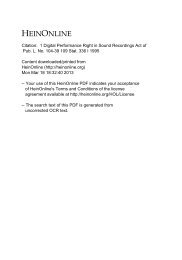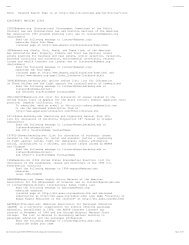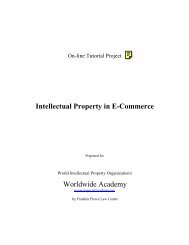BIEDERMANN MOTECH GMBH and Depuy Spine, Inc, Plaintiffs
BIEDERMANN MOTECH GMBH and Depuy Spine, Inc, Plaintiffs
BIEDERMANN MOTECH GMBH and Depuy Spine, Inc, Plaintiffs
You also want an ePaper? Increase the reach of your titles
YUMPU automatically turns print PDFs into web optimized ePapers that Google loves.
"provided with two holes for receiving a rod [ (16) ]." The patent attorney who drafted the patent<br />
application did not provide reference numerals for the "holes" limitation, which might have clarified exactly<br />
what was intended. Claim 2 reads:<br />
Device according to claim 1, characterized in that said receiver member (5) comprises in the portion thereof<br />
facing away from said bore (8) at least one slit (17) extending up to the open side thereof, said receiver<br />
member further comprising two mutually opposite slits (12, 13) for passing said rod (16) <strong>and</strong> for receiving<br />
locking nuts (24, 25), the slits (12, 13) being angularly offset with respect to said slit (17).<br />
('678 patent, cl. 2, at col. 4 ll. 25-32.) For this discussion, the key point is that the receiver member "further<br />
compris[es] two mutually opposite slits (12, 13) for passing said rod (16) <strong>and</strong> for receiving locking nuts (24,<br />
25), the slits (12, 13) being angularly offset with respect to said slit (17)."<br />
Comparing the language from the two claims, it is apparent that claim 2 unambiguously states that the<br />
receiver member has "two holes for receiving a rod [ (16) ]" <strong>and</strong> "two mutually opposite slits (12, 13) for<br />
passing said rod (16)." In other words, a device infringing on claim 2 must have a gr<strong>and</strong> total of four<br />
holes/slits which receive/pass a rod. The reason is that claim 2 uses the phrase "further comprising" which is<br />
st<strong>and</strong>ard in dependent claims for adding additional elements to a device. Manual of Patent Examining<br />
Procedure, s. 608.01(n), Dependent Claims (2007). If the patent attorney wished to limit the "holes" to<br />
being slits, the proper terminology would be "in which," as in "in which the holes for receiving a rod (16)<br />
are two mutually opposite slits (12, 13) for passing said rod (16) <strong>and</strong> for receiving locking nuts (24, 25), the<br />
slits being angularly offset with respect to said slit (17)." This reading is supported by the distinction made<br />
in the claims between "receiving a rod [ (16) ]" <strong>and</strong> "passing said rod (16)."<br />
This reading is unambiguous, because claim 1 uses the term "holes" without a reference number. If "two<br />
holes" had reference numbers, <strong>and</strong> the same reference numbers were used in reference to the "two mutually<br />
opposite slits (12, 13)," then perhaps there would be an ambiguity in the claim. Ambiguous claims can be<br />
interpreted to achieve the inventor's desired meaning. See Honeywell, <strong>Inc</strong>. v. Victor Co. of Japan, Ltd., 298<br />
F.3d 1317, 1322-24 (Fed.Cir.2002). As written, however, the claim is unambiguous, <strong>and</strong> unambiguous<br />
claims must be interpreted as written.<br />
This court, however, repeatedly <strong>and</strong> consistently has recognized that courts may not redraft claims, whether<br />
to make them operable or to sustain their validity. Even "a nonsensical result does not require the court to<br />
redraft the claims of the ... patent. Rather, where as here, claims are susceptible to only one reasonable<br />
interpretation <strong>and</strong> that interpretation results in a nonsensical construction of the claim as a whole, the claim<br />
must be invalidated." "Where, as here, the claim is susceptible to only one reasonable construction, ... we<br />
must construe the claims based on the patentee's version of the claim as he himself drafted it."<br />
Chef America, <strong>Inc</strong>. v. Lamb-Weston, <strong>Inc</strong>., 358 F.3d 1371, 1374 (Fed.Cir.2004).<br />
In Chef America, the sole issue on appeal was the meaning of the following claim language: "heating the<br />
resulting batter-coated dough to a temperature in the range of about 400 degrees F. to 850 degrees F." Id. at<br />
1372. The question was whether the dough itself was to be heated to that temperature or whether the claim<br />
only specified the temperature at which the dough was to be heated, i.e., the temperature of the oven. Id. at<br />
1373. The problem was that if the batter-coated dough was heated to the specified temperature range, it<br />
would be burned to a charcoal-like briquette. Id. Thus, the patentee argued that the claim language referred<br />
to the temperature of the oven, not the dough, <strong>and</strong> the word "to" should have been construed to mean "at."






